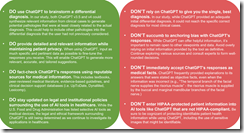EPtalk by Dr. Jayne 7/25/24
Although technology continues to advance, we are still leaving patients behind. The Washington Post reported recently that 40% of women are delaying their recommended health screenings. The top reasons cited include time constraints, cost, anxiety, and worries of pain during testing.
Other interesting findings: 31% of Gen Z respondents found it difficult to find relevant information on screenings, and 63% of respondents said they struggled to prioritize their own health. We talk a lot about insurance in the US and trying to make sure services are covered, but the reality is that a large number of workers don’t have paid time off for medical appointments or other health-related matters.
When you figure that a single preventive service can eat up a half day of time (travel, filling out forms, waiting, having the service, and returning home) and there are between five and 10 services needed each year for average-risk women, you can see how it adds up. Organizations should be doubling down on strategies to make screening services more accessible, whether it’s online scheduling, completing pre-visit forms from the comfort of your home at the time of your choosing, or reducing anxiety by providing an efficient results communication process.

Given the number of healthcare conferences that are being held now, it seems like there is more competition to prove which will be hipper or cooler than the rest. HLTH has opened submissions for its Art Gallery, asking those on its email list “Could you be the next Andy Warhol?” The call for submissions notes that “this unique fusion of healthcare and artistic expression highlights the connection between wellbeing and art, creating a sanctuary where science meets the soul, and personal stories of hope come to life.” That’s quite an aspirational goal. Art will be displayed as digital prints and should be created by someone who has undergone medical treatment or works in healthcare. There are no prizes, and if you’re selected and want to see your work on display, you’ll have to buy a ticket at the then-current price. Registrations are $2,895 as of this week and will go up to $4,100 towards the end, so I hope all the artists are saving their pennies.
I learned a new word this week, as an article in the Harvard Business Review discussed AI-generated inaccuracies. According to the authors, “botshit” is “made-up, inaccurate, and untruthful chatbot content that humans uncritically use for tasks.” I have no issues with how they’ve defined it and am glad they added the last piece about the role of humans incorporating bad information into their workflows or decision making. I know of several clinical colleagues that are using commercially available nonmedical generative AI to help create clinical documentation, and it’s amazing how unconcerned they are with the potential for introducing errors into patient charts. Lest my jaw spend too much time on the floor, I remind myself that some of these individuals are probably those who had a macro added to their chart notes that said something along the lines of “Dictated but not read, signed by staff to expedite” or other such nonsense.
In my clinical practice, the greatest use I’ve found for generative AI tools is to help me confirm something that I suspect or already know, but haven’t encountered in a while. For example, is what I remember as the first-line drug for treating Lyme disease still preferred? Since I live in a state where Lyme is not endemic, I rarely see the condition, but on the other hand, it always seems to pop up as a board certification question, so I can’t let it fall too far by the wayside. It’s less useful for the situations where I think it could really be beneficial, such as trawling the world’s literature to try to figure out what is the next best step for a complex patient with certain parameters. As a physician, that’s where I really need help since the textbook answers rarely take into account such factors as the patient’s insurance coverage or ability to adhere to a treatment plan.
From Remotely Employed: “Re: return to office policies. They continue to plague tech companies. Check out this article about Dell employees who fought back in response to the company’s negative actions toward remote workers.” The annual Tell Dell employee engagement survey apparently got an earful, with the employee net promoter score dropping from 63 to 48 over the course of the last year. Of course, a Dell spokesperson tried to spin it, mentioning that “Dell is still well above industry averages.” The old “yeah, but other people are worse” deflection hasn’t worked well for many organizations in the past, so negative points for lack of imagination in their response. Dell had announced earlier this year that employees who were remote as opposed to hybrid would have fewer opportunities for career advancement. They also began color coding employees based on how often they were in the office.
The comments on the article are reflective of dissatisfaction with in-office roles that workers feel can be done equally well on a remote basis One noted that costs of commuting are a major concern, and another described the HR policies as “ham-handed” and recommended that the organization “focus on productivity and an individual’s contribution to the operation, and make personnel decisions based on that.” It’s a novel concept now that we’re seeing more organizations treating employees like children. One of my neighbors who worked remotely for years is on a team that has no other members in our city. Still, he dutifully goes to the office three days a week, attending video calls with others across the country. I’m guessing management thinks his quality of work is somehow better after an hour commute in stressful traffic.
I’ve been walking a mile in my patient shoes this week, waiting for pathology results that were significantly delayed. The practice is attributing the problem to CrowdStrike, although I’m not sure I’m buying that excuse. I know a lot of diagnostic vendors had problems with their dictation software, but where was the downtime plan? Did they just stop reading pathology slides while they waited for the dictation software to come back up?
Based on a phone call I received on Friday, my slides were being read that afternoon, so it’s been a maddening wait over the weekend and into this week. I encourage anyone who deals with healthcare IT systems to spend just a minute thinking about the patients on the other ends of all these transactions, and what it might feel like to them when something like this happens. Let’s get our downtime ducks in a row, folks. Would you really want your loved ones to be treated this way?

Email Dr. Jayne.


















I've figured it out. At first I was confused but now all is clear. You see, we ARE running the…